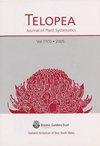单叶蓝属(豆科:豆科)的附加种。
IF 0.5
4区 生物学
Q4 PLANT SCIENCES
引用次数: 0
摘要
描述了单叶靛蓝的另外两个种。Indigofera brennanii Peter G. Wilson是最近发现的一个分类群,它出现在格鲁特·埃兰德和毗邻大陆的Limmen国家公园。indiofera fibriolata Peter G. Wilson是一种地理上孤立的物种,生长在昆士兰州的Bulleringa国家公园;它以前被包括在I. rupicola。虽然这两个分类群都在国家公园中被发现,但它们的保护状况尚未得到评估。本文章由计算机程序翻译,如有差异,请以英文原文为准。
Additional species in the Indigofera haplophylla group (Fabaceae: Faboideae).
Two additional species in the Indigofera haplophylla are described. Indigofera brennanii Peter G. Wilson, is a recently discovered taxon that occurs on Groote Eylandt and in Limmen National Park on the adjacent mainland. Indigofera fimbriolata Peter G. Wilson is a geographically isolated species that occurs in Bulleringa National Park, Queensland; it was formerly included in I. rupicola. Although both taxa are found in national parks, their conservation status has not been assessed.
求助全文
通过发布文献求助,成功后即可免费获取论文全文。
去求助
来源期刊

Telopea
PLANT SCIENCES-
CiteScore
1.30
自引率
42.90%
发文量
0
期刊介绍:
Manuscripts submitted for publication in TELOPEA are published online, after peer review and acceptance by the TELOPEA Editorial Committee and when final editorial formatting has been completed. The journal specialises in plant systematics and phylogeny. The geographic scope of the journal encompasses Australia, Malesia, Melanesia, Micronesia, and Polynesia. The suitability of a work for the journal depends on the topic and the region of origin, generally the narrower the focus of the manuscript the closer to New South Wales must be its geographic focus.
As a general guide, we will consider:
1) revisionary treatments and other substantial bodies of work from any of the regions mentioned above.
2) new species from any Australian state.
3) new country records for Australia from any state.
4) new state records from New South Wales only.
However, we aim to support botanical research across the broader Australasian and Pacific region, and will consider submissions on their merit.
Generally we will not consider extraterritorial new country records, or single lectotypification papers unless they pertain to New South Wales taxa, or have significant bearing on the Australian flora.
 求助内容:
求助内容: 应助结果提醒方式:
应助结果提醒方式:


